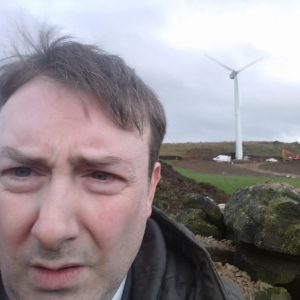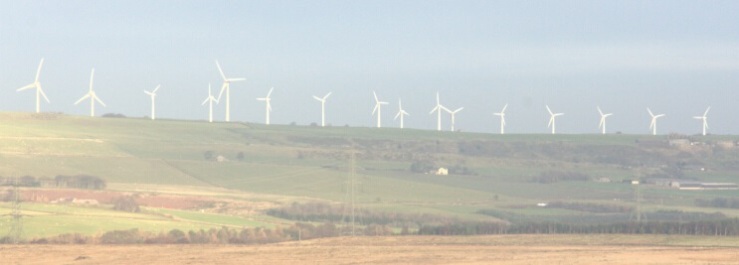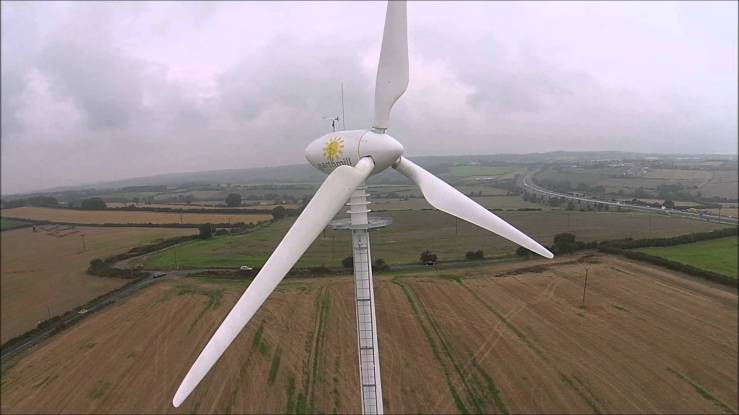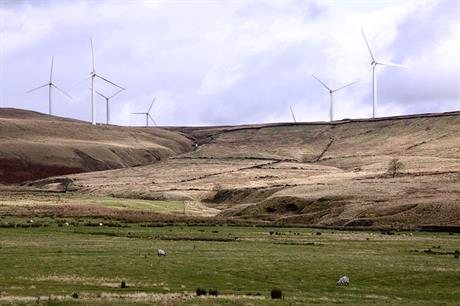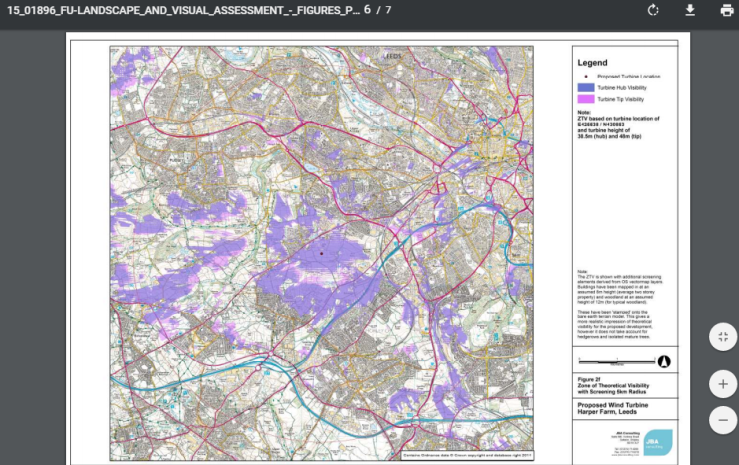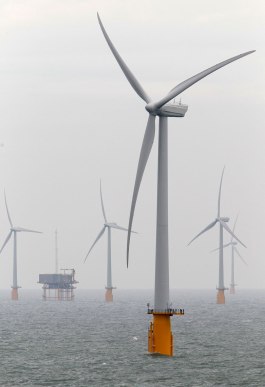
I’ve already described myself as a proud wind turbine Banana (Build Absolutely None Anywhere Near Anyone). Culture wars are raging on both sides of the Atlantic between us Bananas and our deadly rivals, the Watermelons. This could get messy…anyone for fruit salad?
In case you didn’t know, Watermelons are those who are Green on the outside but Red on the inside. A few years ago down in Brighton, a significant skirmish took place between Bananas and Watermelons over whether to pull down a century-old oak tree to make way for a new cycle lane. I forecast a long, protracted and acrimonious period of fighting for the two factions, as the impact of the under-construction Rampion Offshore Wind Farm (**WORST UK ECO DISASTER OF THE 21ST CENTURY**???) begins to envelope the formerly-raffish seaside resort in a miasma of retributions, blame and sheer pig-headed denial.
One has to reserve judgement and tread carefully, keeping an open mind and not actively wishing harm, just in order to say “I knew this would happen”. That would be pure selfish ego, as we are still seeing with some Remainers. Not all Remainers, clearly, not those who have reluctantly accepted the democratic endorsement of the Brexit thesis, despite it being the antithesis to their own views. We need both sides to come to the table to work towards a mutually agreeable synthesis. And so I have to be the bigger man and just hope that, now that we’re lumbered with it, the Rampion Wind Farm at least does some good in the world, rather than killing off one of the UK’s top seaside resorts (it would be a self-administered death to be fair, a Darwin Award for the entire Green Party).
I am sceptical though, and more than a little concerned that dead whales might start regularly floating up onto the beaches between Portslade and Peacehaven. But I don’t actively want it to happen. I don’t want thousands of people, many of them elderly, to find they can no longer sit outside and gaze off into the seemingly endless blue sea, as I myself used to do when I briefly lived in Brighton back in 2002. Strange to think that this former home town, where I used to DJ and throw club nights, is now languishing somewhere at the very bottom of places in the UK I’d like to visit. I can’t see me going back to Brighton for the next 20 years to be honest. Still, if that’s what the residents want, let them live with it. Maybe if everyone else moved to Hastings or Bournemouth, the remainder might get the message that normal holidaymakers don’t want to sit staring at a power station for hours on end.
We Bananas tend to have more in common with the central Brexit thesis than its Remain antithesis – ours is a different kind of environmentalism that maybe does start with protecting our own back yards, but certainly doesn’t end there. The Watermelons believe in a different kind of environmentalism, epitomised by Agenda 21 and enacted by supranational organisations such as the UN and the EU.
I wear my biases on my sleeve, but I explain where they come from and am always on the lookout for the antithesis to my own thesis. I’ve proven it often enough (see the previous entry for some good knockabout self-debating!) My bias comes from loving the earth beneath my feet, which happens to be British soil, not through choice but through the randomness of life. So be it. If I don’t like it here, I am free to leave. Luckily, there’s nowhere else on earth I’d rather be. Not that British is best, but it’s definitely the best for me.
Right now I’m in Leeds so I start with my own city, and spiral my focuses outward from there. To the South lies the Peak, to the north lie the Dales, so I am blessed to have two of the world’s most stunning National Parks on my doorstep. But these landscapes are for everyone, we don’t want to keep them for ourselves, far from it. It’s the millions of visitors every year who keep these places vibrant, alive and worthy of protection, constantly thrilling and exciting first-time visitors with their gobsmacking natural landforms, such as Mam Tor, Kinder Scout, Pen-Y-Ghent, Ingleborough, Malham Cove etc.
Bananas tend to start with their own cognitive processes and spiral out from there to come up with an original theory or two, whereas Watermelons tend to start with pre-defined theories, and then apply them to their own experiences. In truth, reality is a bit of both, a SYNTHESIS of both our own empirical evidence and underlying theories formulated by experts.
These are the two starting points upon which our environmental policy debate is based: eco-destruction as perceived directly by our senses (Bananas) vs eco-destruction as explained theoretically (Watermelons). Nothing epitomises this divide more than wind farms.
The justification for wind farms is basically as a “techno-fix”, ie a mechanical solution for tackling climate change, an issue which as I have already explained is not most efficiently or ergonomically solved by trashing our health-giving uplands; however at least I understand, and up to a point agree with, the theory that leads people to think of wind turbines as a solution. If CO2 emissions are the problem, and wind turbines fix that problem, it’s a no-brainer, right?
The trouble with the theoretical Watermelon approach is that there is nobody on earth who can detect climate change through their senses alone, well not until the point where the icecaps melt and Stoke-on-Trent becomes Stoke-on-Sea. Therefore the minute we base our environmentalist discourse on the climate change thesis, the very foundation for our viewpoint rests on other people’s theories, that we only even 1% understand, using modelling data we have never seen, and that even the experts can’t agree exactly what it means.
That’s not to say I don’t believe in man-made climate change, far from it, just that my sole means of finding out about it comes from theory rather than my own experience-based observations: from institutions, governments, journalists and millions upon millions of opinion articles. Overwhelming, confusing, prone to exaggeration, misinterpretation and distortion – how the hell can a normal person make a truly informed decision about climate change?
Clearly the lower our toxic emissions, the better all round. But to proactively add more eco-destruction that has a dreadful impact on our senses, on a scale hitherto unknown, and in locations hitherto sacrosanct, in the name of something so theoretical as climate change, is the hallmark of a true Watermelon. The theory says it’s right, and that comes first. The psychological and emotional impact of the policies upon come a distant second.
Bananas, on the other hand, start at home, with our own garden, or a nearby field, or down at the river, and we contemplate how it makes us feel. If we experience eco-destruction, no matter what its theoretical benefits, it makes us feel bad, and we try to understand what on earth it is about it that has such a negative impact upon us.
In doing this, we may formulate our own counter-theories that challenge the existing theories of the Watermelons. In time, a natural synthesis will evolve, and a general consensus will form. However new generations may then find that their own experiences no longer adhere to the synthesis we arrived at, and they too will come up with their own antithesis. And so it goes on…that’s progress!
Honestly identifying flaws in a product or service and responding to feedback from the public is an essential part of technological innovation. A business ignores the genuine views of the public at its peril.
This is why I proactively like to engage with young voters and bring the topic of wind blight to their attention. To bring it into the Overton Window of relevant topics that our future political leaders consider important. The wonderful health-giving properties of the Peak and the Dales are certainly not lost on the 20-somethings of the North. The tricky part is highlighting the damage to the other parts of the Pennines caused by industrial wind blight, ever-encroaching into these magical watershed landscapes.
Now here’s the bit I want to say to my fellow Wind Warriors, in the hope it will help you better advance your arguments with those who might be most difficult to get through to. If the left gets UKIP wrong, then maybe equally sometimes the right gets the Greens wrong, so allow me to explain.
Green voters are just as intelligent, rational and reasonable as anyone else. Often young and unworldly, but absolutely not stupid or irrational. Far from it, Green Party policies are way more theory-based and intellectual than their detractors might realise.
I believe Green Party voters can best be reached through high-level intelligent discourse.
I would suggest that there’s something else that separates Bananas from Watermelons, and once again it is psychological in its roots. I would suggest that maybe the fundamental difference is that Watermelons tend to have an external locus of control, whereas Bananas veer towards an internal locus of control. Brains or ethics don’t come into it. Watermelons too have their amygdala hijacks and react accordingly. But whereas an amygdala hijack will ultimately lead to a Banana feeling personally empowered and motivated to set things straight on their own, without the need for outside assistance; oftentimes a Watermelon will feel the situation is out of their control and they need someone else to stand up on their behalf.
Once you recognise the fundamental psychological split, often buried beneath layers and layers of behavioural disguise, and once you realise it’s nothing to do with how nice people are or how bright they are, but simply how much control they feel they have over their own lives, then you can truly understand the battle for the soul of the environmental movement, the battle for Brexit, the battle over Trump, the battle over climate change etc etc. All these culture wars are essentially the global consciousness asking itself how much of this stuff we can do on our own, and how much requires the help of other people?
So this Banana here takes that initial amygdala hijack and uses it to become empowered, determined and more than capable of standing up to the wind bullies, to rub their noses in their own eco-destruction, to stop at nothing to personally protect the landscapes near me, and to use my passion to help others protect the landscapes near them! Whereas, I would posit, when a Watermelon is hit with an amygdala hijack, they feel less personally able to deal with it on their own, more in need of assistance from the authorities or the experts to get the ball rolling, after which they might start to take the reins.
All this is grossly generalistic, as Hillary described her election-losing “deplorables” observation, and all of us rely ultimately on the authorities to resolve disputes. But that’s the fundamental difference. Bananas start on their own, and build up to a crescendo that may well end up with the the full force of the law behind them, whereas Watermelons tend to start with an authority/establishment/expert decision, which they then apply to everything they experience, and fall back on that default appeal to authority whenever experiencing an amygdala hijack. Maybe you can even tell a future Banana from a Watermelon from the day they start primary school. A Banana will fight back when attacked by a bully; a Watermelon will tell the teacher.
At the small festival I just attended, I saw a number of stalls, one of which stood out for me in particular, the Greenpeace stall. Compare this to the adjacent stall, a small independent vegan cafe. Greenpeace is a global organisation that has found a way of cascading its PR down to intimate local festivals. Top-down. Draconian climate change policies. If they run out of leaflets, they would be able to report back to head office and get extra supplies sent over. External locus of control. Whereas the vegan cafe…Grass roots. Home-grown produce. If they run out of kale, then, game over, unless they can find their own way of getting more delivered asap. Internal locus of control.
To confuse matters, often a Watermelon operation will disguise itself as grass roots, without revealing the hidden hand behind-the-scenes pulling all the strings (known as “astroturfing”). Occasionally, you might even get the odd Banana operation disguising itself as something that has global backing, when it fact it’s just a couple of herberts doing their own thing. Lonewolf bombers sometimes do this, claiming to be part of a major terrorist group when in fact they’re just suffering from their own private, and highly dangerous, amygdala hijacks.
So yes, I admit, some Bananas are bad people. But the difference is not about good vs bad, or smart vs stupid, or thoughts vs feelings, or male vs female, or black vs white, or even left vs right (lifelong Eurosceptic Jeremy Corbyn definitely has something of the Banana about him, whereas Tony Blair’s ardently pro-EU stance was pure Watermelon!). The ultimate difference is whether people’s locus of control is essentially internal or external, and the cross-party EU Referendum debate encapsulated the difference politically: do we as a society want the UK’s locus of control to be internal or external? Answer: Internal.
I hope I’m proving that, although I’m a Banana first and foremost, I have no disrespect for Watermelons as people, I believe I understand their psychology, especially when it comes to climate change. They feel powerless to prevent it on their own, and that such a vast issue requires top-down solutions rolled out, as per Agenda 21, which we’ll come onto shortly. Wind turbines are the natural outcome of such a policy framework. Whereas us Bananas start with first-hand experience of the eco-destruction of the lands we know and love, and then we work outwards from there.
If a Watermelon can’t empathise with a Banana getting upset at seeing the countryside devoured by machines, then they’d do well to ask themselves what on earth they’re doing in the Green Party. That, ultimately, is why I come down on the side of the Bananas.
No theory or academic paper in the world can remove the emotional sting and psychological impact of seeing our treasured landscapes trashed for profit.
Yes I’m proud to be a Banana, but I’m friends with loads of Watermelons and I know they’re not bad or stupid people, far from it. More often than not, they’ve never experienced the negative impact of wind energy for themselves. They just feel overwhelmed by the threat of climate change, helpless to tackle it on their own, promulgating directives and talking points that actually originate from big, shadowy agencies, who often don’t have their best interests at heart.
We Bananas say instead: take control, open your eyes, ears and senses to the world around you, engage directly with nature, love the soil beneath your feet, stand strong, and you really can change the world, with nobody else’s thoughts, feelings or ideas but your own!
Ultimately, we all need to work together on environmental issues, so I hope understanding a bit more about the psychology of our political adversaries may help us come to a mutually beneficial synthesis that makes this a better place to live, without needing the help of wind turbines. There’s got to be other ways…let’s start looking for them, together 🙂
Just saying… http://www.theargus.co.uk/news/15502115.Ships_investigated_in_toxic_cloud_mystery/
http://www.bbc.co.uk/news/uk-england-sussex-21702452
http://changingminds.org/explanations/preferences/locus_control.htm
EDIT: As always, my first critic is myself! Maybe there’s a link between critical thinking and DJing… in case you didn’t know, my introduction to low frequency rumbles didn’t come from wind turbines, but from sound systems. Maybe that’s why I’m so sensitive to the negative impact of out of phase infrasonic frequencies; a wind farm’s soundwaves are like a DJ playing 12 songs at once, each out of rhythm with each other. Strewth!
DJing involves listening in headphones to the song you’re playing next, while people are still dancing to the song you’re playing now. Being one step ahead. Knowing in advance that the song you had cued up next might in fact not be the best song to play, and changing your mind before the public even notices!
And so…I hear the voice of critical thinking in my headphones. Woah, woah, woah, it shouts. Hold on, hold on, hold on…how the hell can you describe people who want to be self-sufficient, generating their own power using their own wind turbine, as having an external locus of control?! Surely they are the biggest Bananas of the lot? OK, they might have a small turbine of their own, but only as an alternative to huge, filthy coal or gas-fired power stations, which have way more visual impact on way more people.
Serendipity came to my rescue! I genuinely didn’t have an answer for this, until yesterday evening when I saw a Sponsored Post on Facebook. The post, for a suspicious-looking group called 10:10 Climate Action, which seems to be pure Watermelon (if ever in doubt, ask yourself: IS THIS GENUINELY GRASS ROOTS, OR IS THERE SOMEONE IN THE SHADOWS PULLING THE STRINGS???), features a poll: “Which would you rather live next to, a wind farm or a fracking site?”, illustrated by a wind turbine (minus concrete foundations, substation, cabling, pylons and HGV access tracks, which always seem to get missed out of cartoon depictions of wind turbines) and a fracking well (illustrated with a huge hole in the ground). I added a comment: “Here’s my answer….[link to here]…Enjoy!”
I hope the Watermelons behind 10:10 Climate Action are reading every word of this, because you’ve been rumbled, and you’ve helped answer my awkward question. Well, one of your contributors did, with an excellent point that I’ve never heard before. See, it’s not just a case of the wind turbine powering a property on its own, like a phone charger. All that happens is the wind turbine “feeds in” to the National Grid. Same electricity supply for everyone. So the wind turbine feeds some supply into the grid, not a lot to be honest, which the property then draws back out in its use of electricity. And that’s why a private wind turbine is still, and always will be, a Watermelon concept: Green and self-sufficient on the outside, but Red and externally-controlled on the inside.
The fact is, when it comes to electricity we are all Watermelons to a certain extent, which is annoying, but that’s the nature of electricity. Electrical appliances require a standardised current; if you buy an iPad and I buy an iPad, we both need exactly the same amounts of volts, amps, watts and ohms to make them work. Is it even possible for an individual to generate their own perfectly calibrated electricity, just by means of a wind turbine alone? Or does the turbine merely feed into the grid, possibly contributing a tiny, token amount of power, whilst still at heart relying on the same old coal and gas-fired power stations that we all use? You can’t just set up a turbine on your own and expect your iPad to start working; you need it to be assimilated into the existing grid and its erratic current regulated, which is pretty much a drain on resources for all involved. Lord knows why ANYONE would get a wind turbine!
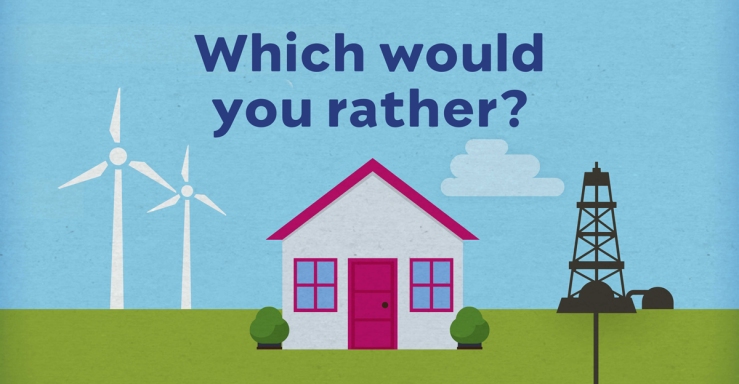
HERE WE GO AGAIN. You need to read this, 10:10 Climate Action… https://www.facebook.com/notes/johnstown-wind-action-group/a-wind-farm-lament/1154673064678097/
